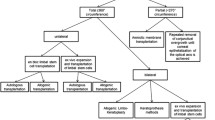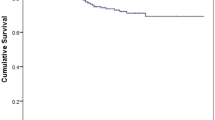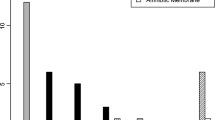Abstract
Purpose To evaluate the outcome of primary adult optical penetrating keratoplasty (PKP) performed with internationally acquired donor tissue. Patients and methods A retrospective review was performed of the medical records of every patient 12 years of age or older who underwent PKP for keratoconus, corneal edema, stromal scarring, or stromal dystrophy at King Khaled Eye Specialist Hospital in the Kingdom of Saudi Arabia between January 1, 1997 and December 31, 2001, and for whom a minimum of 3 months’ follow-up was available. Results Of 885 eyes that met the inclusion criteria, there were 453 eyes with keratoconus, 180 eyes with corneal edema, 171 eyes with stromal scarring, and 81 eyes with stromal dystrophy. For the entire group, the probability of graft survival was 96.9% at 1 year, 86.0% at 3 years, and 80.3% at 5 years. The 5-year probability of graft survival was 96.2% for keratoconus, 39.4% for corneal edema, 71.1% for stromal scarring, and 85.2% for stromal dystrophy. Increasing donor age was significantly associated with an increased risk of graft failure on multivariate Cox proportional hazard regression analysis (P = 0.005). Endothelial cell density, death-to-preservation time, and preservation-to-surgery time were not significantly associated with an increased risk of graft failure. Conclusions In our patient population, excellent graft survival was achieved utilizing internationally acquired donor tissue for eyes with keratoconus, stromal dystrophy, and stromal scarring, but not for those with corneal edema.

Similar content being viewed by others
References
Kaufman HE, Beuerman RW, Steinemann TL et al (1991) Optisol corneal storage medium. Arch Ophthalmol 109:864–868
Lass JH, Bourne WM, Musch DC et al (1992) A randomized, double-masked clinical trial of Optisol vs. Dexol corneal storage media. Arch Ophthalmol 110:1404–1408
Lindstrom RL, Kaufman HE, Skelnik DL et al (1992) Optisol storage medium. Am J Ophthalmol 114:345–356
Bourne WM, Hodge DO, Nelson LR (1994) Corneal endothelium five years after transplantation. Am J Ophthalmol 15:185–196
Means TL, Geroski DH, Hadley A et al (1995) Optisol corneal storage medium. Arch Ophthalmol 113:805–809
Frueh BE, Bohnke M (2000) Prospective, randomized clinical evaluation of Optisol vs. organ culture corneal outcome and recipient graft outcome. Arch Ophthalmol 118:757–760
Bourne WM, Nelson LR, Maguire LJ et al (2001) Comparison of Chen medium and Optisol-GS for human corneal preservation at 4 degree C: results of transplantation. Cornea 20:683–686. doi:10.1097/00003226-200110000-00003
Greenbaum A, Hasany SM, Rootman D (2004) Optisol vs. Dexsol as storage media for preservation of human corneal epithelium. Eye 18:519–524. doi:10.1038/sj.eye.6700693
Wagoner MD, Gonnah ES (2005) Corneal graft survival after prolonged storage in Optisol-GS. Cornea 24:976–979. doi:10.1097/01.ico.0000159731.52801.b6
Wang IJ, Hu FR (1997) Effect of shaking on corneal endothelial preservation. Curr Eye Res 16:1111–1118. doi:10.1076/ceyr.16.11.1111.5111
Antonios SR, Cameron JA, Badr IA et al (1991) Contamination of donor cornea: postpenetrating keratoplasty endophthalmitis. Cornea 10:217–220. doi:10.1097/00003226-199105000-00006
Cameron JA, Antonios SR, Cotter JB, Habash NR (1991) Endophthalmitis from contaminated donor corneas following penetrating keratoplasty. Arch Ophthalmol 109:54–59
Hu FR, Tsai AC, Wang IJ, Chang SW (1999) Outcomes of penetrating keratoplasty with imported donor corneas. Cornea 18:182–187. doi:10.1097/00003226-199903000-00007
Halberstadt M, Athmann S, Winter R et al (2000) Impact of transportation on short-term preserved corneas preserved I Optisol-GS, Likorol, and MK-medium. Cornea 19:788–791. doi:10.1097/00003226-200011000-00006
Chan CM, Wong TY, Yeong SM et al (1997) Penetrating keratoplasty in the Singapore National Eye Centre and donor cornea acquisition in the Singapore Eye Bank. Ann Acad Med Singapore 26:395–400
Fasolo A, Frigo AC, Böhm E et al (2006) The CORTES study: corneal transplant indications and graft survival in an Italian cohort of patients. Cornea 25:507–515. doi:10.1097/01.ico.0000214211.60317.1f
Ing JJ, Ing HH, Nelson LR et al (1998) Ten-year postoperative results of penetrating keratoplasty. Ophthalmology 105:1855–1865. doi:10.1016/S0161-6420(98)91030-2
Inoue K, Amano S, Oshika T et al (2000) A 10-year review of penetrating keratoplasty. Jpn J Ophthalmol 44:139–145. doi:10.1016/S0021-5155(99)00190-2
Muraine M, Sanchez C, Watt L et al (2003) Long-term results of penetrating keratoplasty. A 10-year-plus retrospective study. Graefes Arch Clin Exp Ophthalmol 241:571–576. doi:10.1007/s00417-003-0691-z
Patel SV, Hodge DO, Bourne WM (2004) Corneal endothelium and postoperative outcomes 15 years after penetrating keratoplasty. Trans Am Ophthalmol Soc 102:57–65
Thompson RW Jr, Price MO, Bowers PJ, Price FW Jr (2003) Long-term graft survival after penetrating keratoplasty. Ophthalmology 110:1396–1402. doi:10.1016/S0161-6420(03)00463-9
Price FW Jr, Whitson WE, Collins KS, Marks RG (1993) Five-year corneal graft survival. A large, single-center patient cohort. Arch Ophthalmol 111:799–805
Price FW Jr, Whitson WE, Marks RG (1991) Graft survival in four common groups of patients undergoing penetrating keratoplasty. Ophthalmology 98:322–328
Sit M, Weisbrod DJ, Naor J, Slomovic AR (2001) Corneal graft outcome study. Cornea 20:129–133. doi:10.1097/00003226-200103000-00002
Williams KA, Ash JK, Pararajasegaram P et al (1991) Long-term outcome after corneal transplantation. Visual result and patient perception of success. Ophthalmology 98:651–657
Doganay S, Hepsen IF, Yologlu S, Demirtas H (2007) Effect of preservation-to-surgery interval on corneal allograft survival in low-risk patients. Ophthalmic Surg Lasers Imaging 38:457–461
Ardjomand N, Berghold A, Reich ME (1998) Loss of corneal Langerhans cells during storage in organ culture medium, Optisol and McCarey–Kaufman medium. Eye 12:134–138
Simon M, Fellner P, El-Shabrawi Y, Ardjomand N (2004) Influence of donor storage time on corneal allograft survival. Ophthalmology 111:1534–1538. doi:10.1016/j.ophtha.2003.12.060
Greenbaum A, Hasany SM, Rootman D (2004) Optisol vs. Dexsol as storage media for preservation of human corneal epithelium. Eye 18:519–524. doi:10.1038/sj.eye.6700693
Kim T, Palay DA, Lynn M (1996) Donor factors associated with epithelial defects after penetrating keratoplasty. Cornea 15:451–456. doi:10.1097/00003226-199609000-00003
Machado RA, Mannis MJ, Mandel HA et al (2002) The relationship between first postoperative day epithelial status and eventual health of the ocular surface in penetrating keratoplasty. Cornea 21:574–577. doi:10.1097/00003226-200208000-00008
Gomes JA, Dana MR, Dua HS et al (1995) Positive donor rim culture in penetrating keratoplasty. Cornea 14:457–462. doi:10.1097/00003226-199509000-00003
Fontana L, Errani PG, Zerbinati A et al (2007) Frequency of positive donor rim cultures after penetrating keratoplasty using hypothermic and organ-cultured donor corneas. Cornea 26:552–556. doi:10.1097/ICO.0b013e318074e475
Wiffen SJ, Weston BC, Maguire LJ, Bourne WM (1997) The value of routine donor corneal rim cultures in penetrating keratoplasty. Arch Ophthalmol 115:719–724
Wilhelmus KR, Hassan SS (2007) The prognostic role of donor corneoscleral rim cultures in corneal transplantation. Ophthalmology 114:440–445. doi:10.1016/j.ophtha.2006.09.006
Sutphin JE, Pfaller MA, Hollis RJ, Wagoner MD (2002) Donor-to-host transmission of Candida albicans after corneal transplantation. Am J Ophthalmol 134:120–121. doi:10.1016/S0002-9394(02)01427-7
Al-Assiri A, Al-Jastaneiah S, Al-Khalaf A et al (2006) Late-onset donor-to-host transmission of Candida glabrata following corneal transplantation. Cornea 25:123–125. doi:10.1097/01.ico.0000164777.80879.07
Forster RK, Fine M (1971) Relation of donor age to success in penetrating keratoplasty. Arch Ophthalmol 85:42–47
Boisjoly HM, Bernard PM, Dubé I et al (1989) Effect of factors unrelated to tissue matching on corneal transplant endothelial rejection. Am J Ophthalmol 107:647–654
Chipman ML, Basu PK, Willett PJ et al (1990) The effects of donor age and cause of death on corneal graft survival. Acta Ophthalmol (Copenh) 68:537–542
Palay DA, Kangas TA, Stulting RD et al (1997) The effects of donor age on the outcome of penetrating keratoplasty in adults. Ophthalmology 104:1576–1579
Corneal Donor Study Investigator Group (2008) The effect of donor age on corneal transplantation outcome results of the cornea donor study. Ophthalmology 115:620–626. doi:10.1016/j.ophtha.2008.01.003
Gain P, Thuret G, Chiquet C et al (2002) Corneal procurement from very old donors: post organ culture outcome and recipient graft outcome. Br J Ophthalmol 86:404–411. doi:10.1136/bjo.86.4.404
Al-Rajhi AA, Wagoner MD (1997) Penetrating keratoplasty in congenital hereditary endothelial dystrophy. Ophthalmology 104:956–961
Nishimura JK, Hodge DO, Bourne WM (1999) Initial endothelial cell density and chronic endothelial cell loss rate in corneal transplants with late endothelial failure. Ophthalmology 106:1962–1965. doi:10.1016/S0161-6420(99)90409-8
Al-Muammar A, Hodge WG (2005) Donor age as a predictor of corneal transplant success. Can J Ophthalmol 40:460–466
Miyata K, Drake J, Osakabe Y et al (2001) Effect of donor age on morphologic variation of cultured human corneal endothelial cells. Cornea 20:59–63. doi:10.1097/00003226-200101000-00012
Reinhard T, Böhringer D, Hüschen D, Sundmacher R (2002) Chronic endothelial cell loss of the graft after penetrating keratoplasty: influence of endothelial migration from graft to host. Klin Monatsbl Augenheilkd 219:410–416. doi:10.1055/s-2002-32876
Ohguro N, Matsuda M, Shimomura Y et al (2000) Effects of penetrating keratoplasty rejection on the endothelium of the donor cornea and the recipient peripheral cornea. Am J Ophthalmol 129:468–471. doi:10.1016/S0002-9394(99)00389-X
Price FW Jr, Whitson WE, Johns S, Gonzales JS (1996) Risk factors for corneal graft failure. J Refract Surg 12:134–143
Musch DC, Meyer RF, Sugar A (1993) Predictive factors for endothelial cell loss after penetrating keratoplasty. Arch Ophthalmol 111:80–83
Author information
Authors and Affiliations
Consortia
Corresponding author
Additional information
The staff members of the King Khaled Eye Specialist Hospital Cornea Transplant Study Group are given in the Appendix.
Appendix
Appendix
The King Khaled Eye Specialist Hospital Cornea Transplant Study Group
Physician Members (KKESH): Klaus D. Teichmann, MD; Abdul-Elah Al-Towerki, MD; Michael D. Wagoner, MD
Physician Members (External Consultants): Kenneth M. Goins, MD; Anna S. Kitzmann, MD; John E. Sutphin, MD
Data Coordination Staff: Barbara Elias, CEBT; El-Sayed Gonnah, CEBT; Jamila Al-Shahrani, BSC
Biostatistician: M. Bridgett Zimmerman, PhD
Rights and permissions
About this article
Cite this article
Wagoner, M.D., Gonnah, ES., Al-Towerki, AE. et al. Outcome of primary adult optical penetrating keratoplasty with imported donor corneas. Int Ophthalmol 30, 127–136 (2010). https://doi.org/10.1007/s10792-009-9295-x
Received:
Accepted:
Published:
Issue Date:
DOI: https://doi.org/10.1007/s10792-009-9295-x




